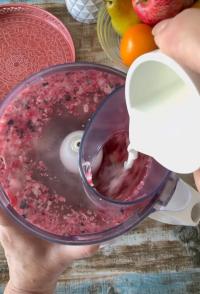Copy Link
Add to Bookmark
Report
HOMEBREW Digest #2015

This file received at Hops.Stanford.EDU 1996/04/19 PDT
HOMEBREW Digest #2015 Fri 19 April 1996
FORUM ON BEER, HOMEBREWING, AND RELATED ISSUES
Rob Gardner, Digest Janitor
Contents:
Hops (A. J. deLange)
Solid CO2 ("Huyck, Randy")
first all grain batch (Bob Wysong)
Stupid Brewer Trick #603 ("Clark D. Ritchie")
Harpoon IPA recipe request (Mark Montminy)
("Bryan L. Gros")
first all grain batch (Correction) (Bob Wysong)
Less Mess while bottling! (Darcy Munger)
Re: Hot Bottles -- one last time (Jeff Frane)
Sorry! Web-page (Randy Jensen)
Dandy Lions. (Russell Mast)
Wanted: Honey-Wheat Recipes (961YATES)
Request for Info on 10 Gallon Cooler-Mash Tun (wiesej)
Thermometer File Now Includes *.txt for the Windows-Impaired (KennyEddy)
RIMS system pictures (hollen)
Isinglass (Algis R Korzonas)
Re: yeast starter/dandelions (Nigel Townsend)
re: kegging, RIMS hoses, CO2 rockets (C.D. Pritchard)
Shakparo, a traditional west african sorghum beer. ("Richard Okambawa")
Culturing yeast to re-use (CHRISTOPHER DIIORIO )
******************************************************************
* POLICY NOTE: Due to the incredible volume of bouncing mail,
* I am going to have to start removing addresses from the list
* that cause ongoing problems. In particular, if your mailbox
* is full or your account over quota, and this results in bounced
* mail, your address will be removed from the list after a few days.
*
* If you use a 'vacation' program, please be sure that it only
* sends a automated reply to homebrew-request *once*. If I get
* more than one, then I'll delete your address from the list.
******************************************************************
#################################################################
#
# YET ANOTHER NEW FEDERAL REGULATION: if you are UNSUBSCRIBING from the
# digest, please make sure you send your request to the same service
# provider that you sent your subscription request!!! I am now receiving
# many unsubscribe requests that do not match any address on my mailing
# list, and effective immediately I will be silently deleting such
# requests.
#
#################################################################
NOTE NEW HOMEBREW ADDRESS hpfcmgw!
Send articles for __publication_only__ to homebrew@hpfcmgw.fc.hp.com
(Articles are published in the order they are received.)
Send UNSUBSCRIBE and all other requests, ie, address change, etc.,
to homebrew-request@hpfcmgw.fc.hp.com, BUT PLEASE NOTE that if
you subscribed via the BITNET listserver (BEER-L@UA1VM.UA.EDU),
then you MUST unsubscribe the same way!
If your account is being deleted, please be courteous and unsubscribe first.
Please don't send me requests for back issues - you will be silently ignored.
For "Cat's Meow" information, send mail to lutzen@alpha.rollanet.org
ARCHIVES:
An archive of previous issues of this digest, as well as other beer
related information can be accessed via anonymous ftp at
ftp.stanford.edu. Use ftp to log in as anonymous and give your full
e-mail address as the password, look under the directory
/pub/clubs/homebrew/beer directory. AFS users can find it under
/afs/ir.stanford.edu/ftp/pub/clubs/homebrew/beer. If you do not have
ftp capability you may access the files via e-mail using the ftpmail
service at gatekeeper.dec.com. For information about this service,
send an e-mail message to ftpmail@gatekeeper.dec.com with the word
"help" (without the quotes) in the body of the message.
----------------------------------------------------------------------
Date: Thu, 18 Apr 1996 08:09:11 -0500
From: ajdel@interramp.com (A. J. deLange)
Subject: Hops
Greg Downing asked about propagating hops shoots. Couldn't be simpler. Poke
a hole in suitably prepared earth and drop the shoot in with the growth tip
and maybe a leaf node or 2 above ground. Water well. There is about a 50%
chance that the shoot will root and grow.
A.J. deLange Numquam in dubio, saepe in errore!
ajdel@interramp.com
------------------------------
Date: Thu, 18 Apr 96 9:12:05 -0700
From: "Huyck, Randy" <rwh0303@hub.doh.wa.gov>
Subject: Solid CO2
I occasionally have access to dry ice (frozen CO2) and am toying with the
idea of using it to purge my secondary fermenters before racking. Does
anyone out there know how much I would need to use to fill a 5 gal.
carboy with gaseous CO2? Also, when this stuff evaporates, it often
accumulates a shell of ice from water vapor in the air--is this a
potential source for contamination? The ice usually remains after the
CO2 has vaporized.
________________________________________________________________________
Just having a hat and a pair of boots doesn't make you a cowboy
_________________________________________________________________________
Randy Huyck
Immunization Program Warehouse
Phone: (360) 664-8688
Fax: (360) 664-2929
MS: 7845
Email: RWH0303@hub.doh.wa.gov
------------------------------
Date: Thu, 18 Apr 96 12:13:39 EDT
From: bob@ocs.com (Bob Wysong)
Subject: first all grain batch
Hello all,
I've just completed brewing my first all grain batch after about 20 extract
batches and have several questions:
(Please excuse the length of my first post, but I feel I need to give details)
For background, the recipe I was using was based on the IPA from
Miller's Complete Handbook....
I used:
6 lbs Klages
1 lb Crystal malt
1 lb light DME (due to low extraction rate)
1 oz Chocolate malt
1 oz Hallertauer 8.5% for boiling
1 oz Cascade 3% last 10 min of boil
1 tsp Irish Moss (last 15 min.. Didn't re-hydrate)
20 oz of starter. Wyeast #1028 (pack was over a year old and took 6 days
to swell) The kruasen on the starter was in a receding mode.
All water used was hot tap water.
I used about 3 gallons of mash water making for a soupy mash.
Boosted the temperature of the mash to 155 without any protein rest.
I had used about 3 teaspoons of gypsum to get the mash down to a PH of
about 5.0
Put in insulated box for 2 1/2 hours. Ending temp was 145. The requirement was
for two hours, but getting the sparge water ready took longer than I wanted.
Then I boosted to 168 degrees for mash-out. (iodine test showed complete
conversion)
For the sparge water, I used an 8% Phosporic acid solution to acidify
6 gallons of hot tap water. After 2 tsps, my PH strips looked like they were
still above 6.0. Then, on the 3rd teaspoon, the PH abruptly changed, and
the test strips remained yellow, indicating that it was now very acidic.
I had to add about 3 more gallons of water before it got back up to about 5.0.
I was expecting just a slow trickle for the sparge, but once I opened the
spigot on my lauter tun, the wort hissed out. (Used the cylindrical cooler with
sparge bag on SS vegetable strainer) It never did slow to a trickle as I was
expecting. I slowed the flow of the output and input so that the sparge would
take about an hour. (The water was 168 degrees, Re-circulated 1st runnings
until clear) NOTE: I don't think the water was leaking thru the sides of the
sparge bag, and it looked like it *was* filtering through the grain bed OK,
which was always held in suspension.
Collected about 8 gallons of wort (ph of the runnings never dropped below
5.8 even though the gravity dropped to about 1.010) and boiled for 90 minutes.
A gravity reading before the boil showed only about 1.020 (granted, it was
8 gallons) prompting me to add 1 lb DME.
I thought I had boiled down to 5 gallons, but was actually 6. (Haven't put
any sort of volume markings in my Sankey keg boiler yet).
Used a CF chiller, shook the 6 1/2 gal car-boy for about 5 minutes to
oxygenate and pitched yeast. FG was only 1.032 at 60 deg F.
No activity for 24 hours. After about 2 days, the krausen remained only about
2 inches (My weakest ferment ever). Since my first "mostly-grain" batch had a
tremendous amount of gray gunk floating on top of the foam, I definitely
wanted it to blow out of my car-boy which had about 6 inches of head space.
So I added about 1 tsp *each* of Yeast nutrient, Yeast energizer, and Amylase
enzyme to 180 degree water and then dumped it in. Also, I swirled the contents
around in the carboy hoping to get the yeast more active. BTW, I have no idea
what the nutrient and energizer consist of.
The gunk never did blow out, and a day later the krausen fell completely,
leaving marble-size gray chunks of matter floating on the surface.
However the fermentation is still going strong. I see a lot of bubbles rise
and break on top of the surface, but they pop immediately. There is now
absolutley *NO* foam on the surface, even though the ferment is still fairly
active. To my knowledge, all of my equipment was clean and I didn't introduce
any oily substances which would cause this.
The smell coming from the fermenting beer is actually very good.
Questions:
1. Does the adding of acid change the PH imediately, or only after a wait
period? (Why the sudden change after the 3rd tsp of phosphoric acid?)
2. Any reason for such a low OG? (sparge water too acidic?)
3. What could cause of the krausen falling? Did I do something to the
head-retention proteins by adding amylase enzyme?
4. Does anything in my procedure sound just plain wrong?
Thanks,
-Bob Wysong
------------------------------
Date: Thu, 18 Apr 1996 09:37:17 -0700
From: "Clark D. Ritchie" <ritchie@ups.edu>
Subject: Stupid Brewer Trick #603
I'd like to add my most recent blunder to the growing list of things *not*
to do.
I just finished sparging my latest pale ale and in doing so, noticed that,
while recirculating the wort to achieve a clear runoff, there was an
extraordinary amount of grain passing through my lauter tun.
I thought to myself, "Self, what's the deal? I've never had a problem
sparging before. What could be wrong?" Well, I just located my problem and
am rather embarrassed to admit my blunder.
After numerous recirculations of the hot liquor, I eventually achieved a
clear (enough) runoff that allowed me to complete the sparge. After the
sparge had completed, I toted the spent grains out back to the compost pile
and dumped them in as usual, except that along with the grains went my false
bottom. It seems as if after cleaning my lauter tun following my last
batch, I forgot to reattach the hose to the false bottom. Doh!
Is my beer ruined? Should I throw it away? Just kidding... CDR
Clark D. Ritchie, ritchie@ups.edu
------------------------------
Date: Thu, 18 Apr 1996 12:34:30 -0400
From: Mark Montminy <markm@dma.isg.mot.com>
Subject: Harpoon IPA recipe request
I'm trying to formulate a recipe for a Harpoon IPA clone. I'm more interested
in a hop schedule, than malt base, since it's really Harpoon's hop profile I'm
after. I'll be doing an extract, full boil. Yeast recommendations are also
welcome.
Email responses preferred. If there's interest, I'll post the resulting
recipe.
On another note....
I use one of the chrome, through the fridge-wall faucets. If I go more than a
day or so between servings, the faucet sticks. I usually have a bugger of a
time to get it to free up. I end up pushing on the sliding part of the shaft
while pulling the handle. Anyone got any tricks for keeping it from "gumming
up", besides the obvious solution of drinking more beer :) I'm thinking of
maybe lubing the shaft with keg-lube?
- --
~~~~~~~~~~~~~~~~~~~~~~~~~~~~~~~~~~~~~~~~~~~~~~~~~~~~~~~~~~~~~~~~~~~~~~~~~
Motorola ISG (508)261-5684 Email: markm@dma.isg.mot.com
~~~~~~~~~~~~~~~~~~~~~~~~~~~~~~~~~~~~~~~~~~~~~~~~~~~~~~~~~~~~~~~~~~~~~~~~~
Adore, v.:
To venerate expectantly.
-- Ambrose Bierce, "The Devil's Dictionary"
------------------------------
Date-Warning: Date header was inserted by ctrvax.Vanderbilt.Edu
From: "Bryan L. Gros" <grosbl@ctrvax.Vanderbilt.Edu>
Subject:
Dave H. in Phoenix writes (re: flavenoids in beer):
> It wouldn't have pleased the budmilloors for the media to say flavenoids
>were found in just about all beer but theirs. Since budmilloors are big
>sponsors
>of the media, I think the story line got slanted to make people think it
has to do
>with the color of the beer rather than the malt content. The big 3 are quite
>carefull to avoid admitting their beers are high in adjuncts or have the public
>even know what an "adjunct" is.
They don't seem to mind admitting they use adjuncts, but they do seem to
be careful to keep the public ignorant to the purpose of their adjuncts.
Don't one or more of the companies advertise corn? Maybe they disguise it
by calling it "choicest grains) or something. I had a bartender tell me the
other
day that he prefers Bud to Miller Light because Bud has that corn taste and
Miller uses a lot of rice. I mentioned that I prefer barley in my beer and I
couldn't tell what his reaction was.
BTW, anyone know what the heart of the hops is? I keep thinking of
artichoke hearts.
- ---------
Dave Beedle <dbeedle@bacchus.net.ilstu.edu> writes:
> The DOT also requires the tank be within current hydro approval. Some
>places will no fill the tank if it is not, others may not notice. I know I
>have a tank that is at least 10 years out of hydro inspection yet the local
>gas place filled it last time. I have since been certified as a tank
>inspector (scuba cylinders) and have dubbed myself as a bad example!
>Hopefully my tank isn't a recalled one and won't descide to explode any
>time soon! It's also a good idea to have the tank visually inspected. I
>don't know the requirements for CO2 tanks but SCUBA tanks should be
>visually inspected once a year (usually) and hydrostatically tested once
>every 5 years. I assume CO2 has some sort of guidelines as well.
>
I considered myself lucky that the local shop filled my bottle last month.
I think the most recent date (about five down) is 88. How much does
it cost to get the tank hydro tested? And what is a visual inspection?
Can we do it at home, or do we need to go to an expert?
Seems like no one in Nashville has ever heard of a 15 pound CO2 tank.
I thought maybe mine could be a tourist attraction and I could charge
people a buck to see it!
- Bryan
grosbl@ctrvax.vanderbilt.edu
Nashville, TN
Copyright 1996. Do not reprint without permission.
- Bryan
grosbl@ctrvax.vanderbilt.edu
Nashville, TN
------------------------------
Date: Thu, 18 Apr 96 12:52:34 EDT
From: bob@ocs.com (Bob Wysong)
Subject: first all grain batch (Correction)
In my 1st post I mentioned that the ph in the sparge runnings
never dropped below 5.8. I *meant* that it never got *above*
5.8, which I read somewhere is the limit before it gets too alkaline.
-Thanks again
-Bob Wysong
------------------------------
Date: Thu, 18 Apr 1996 10:51:28 -0700
From: Darcy Munger <darcym@workgrp.com>
Subject: Less Mess while bottling!
Fellow Brewers,
Let's face it, homebrewing is a messy job. Right now my kitchen floor is so
sticky I had to forcefully pull my 6 year olds tennies off. %~@ This is
after a brewing marathon (5 gallons of Pale, 5 gallons of Irish Red and 1 of
Stawberry Mead all within 48 hours -whew!) Being a female and an addicted
brewer (the husband is content to merely taste, critique and occassionally
lift a heavy carboy) I am happy to find any hints to make it a less messy
process. Anyway a friend who I ran into at the brew store, had an excellent
idea for avoiding some of the inevitable mess of bottling.
1. Empty your (clean) dishwasher completely.
2. Pull out the top rack and line up your sanitized bottles right side up.
Put your carboy on the counter above dishwasher.
3. Rack into bottles.
4. Put each bottle on the counter to cap.
5. Close the dishwasher and let all the spilled beer run into the
dishwasher, not the floor! :~)
I have also SERIOUSLY considered putting in a drain in the floor, and using
a hose to spray it off, functional, but definitely causes (more) gossip
about me at the PTO meetings. ;~)
Well, I have got a floor to scrub.
Thanks for all the great hints.
Cheers!
Darcy M.
------------------------------
Date: Thu, 18 Apr 1996 10:46:52 -0700
From: jfrane@teleport.com (Jeff Frane)
Subject: Re: Hot Bottles -- one last time
Russell Mast and I have been [arguing?] discussing bottle
sanitizing, ovens, and breakage:
Russell wrote:
>
>I find it pretty hard to believe you've never broken a single bottle - I know
>a lot of bleach sanitizers who've had a broken bottle or two now and then.
>
Well, the truth is that my wife knocked three bottles of the cellar stairs
a couple of weeks ago -- so I've broken (well, *I* didn't) three now.
>
>> For me, the great advantage is that I can break the process up into
>> manageable lumps. I can wash one day, sanitize another day, and fill
>> yet another day. No hassles, and no exploding bottles.
>
>But, you have to decide three days in advance when you're going to bottle
>a batch. That works for a lot of people, but not for me. I usually would
>bake the bottles only a few hours in advance. That's real bad.
>
Just to clarify: the three days I described in my bottling "method" are
not contiguous days; that's the great advantage, for me. I wash them
when I have the time and then put them away; same for sanitizing,
because I put them in the oven with foil covering the mouth of the
bottle. I only need to know that I'm going to be bottling sometime
in the next few weeks -- which, given that I've just brewed recently,
isn't too difficult to figure out.
As I wrote privately to Russell, this all means that I can bottle
a ten-gallon batch of beer in about one hour. And then go back to
doing something fun.
- --Jeff Frane
Copyright 1996 by whoever wants it
------------------------------
Date: Thu, 18 Apr 96 11:40:56 PDT
From: rjensen@ainet.com (Randy Jensen)
Subject: Sorry! Web-page
Sorry everyone!
The correct address for the St. Stan's UNOFFICIAL (and currently weak) web
page is:
http://www.ten-four.com/ststans.htm
The .htm extention is NECESSARY. I didn't realize that!
Sorry again!
- ----------------------------------------
- rjensen@ainet.com - Randy Jensen -
- find me at: -
- N37*31'43" W120*53'04" -
- ----------------------------------------
"Deep in the chaotic regime, slight changes in structure
almost always cause vast changes in behavior. Complex
controllable behavior seems precluded.
-STUART KAUFFMAN
------------------------------
Date: Thu, 18 Apr 1996 14:20:05 -0500
From: Russell Mast <rmast@fnbc.com>
Subject: Dandy Lions.
> From: cuncaphe@isd.net (Jinjer)
> Subject: Sunlight on the hops vine
> Be gentle. This is my first post.
Actually, the chemical which "goes skunky" isn't present in hops, it's only
after hops undergo a vigorous boil.
> P.S. Has anyone tried brewing with dandelion or alehoof (creeping charlie)?
I made a dandelion wine last year. I understand it will take a long time to
ferment. I'd recommend a wine or mead instead of a beer, but diff't strokes.
I picked a bunch of dandelion heads. They say it's best to peel apart the
petals and only use the yellow parts, but I used the whole head. You don't
want the stalks at all. (Supposedly the green parts are really nasty and
bitter, but that this flavor diminishes greatly with age. I can wait.)
Anyway, I had about 1.5 gallons loose, and poured in a gallon or so of water,
and heated it. I don't think I boiled, just simmered. Then, I poured this
through a strainer, and I had about a gallon left. I took a gravity reading,
it was like 1.006. So, I added a bunch of corn sugar. I would have done
honey, but I didn't have any and didn't have time to grab some. I put, um,
maybe 2 lbs of sugar in. (I have notes on this all at home.) I believe I
used champagne yeast. Anyway, I still haven't tasted the stuff, I hear it
takes a long time to age, especially with the greens in there.
It smells good and tasted okay when I racked it a couple months back. A
little "hot" and "young", but that's expected. If I were to make another
one this year (I have since moved, in fact I moved the very next day, to
a place with less plant life), I would use more dandelions.
As for the creeping charlie thing, I have no clue, I've heard they're good
with napalm. (I couldn't resist. Apologies to anyone with good taste,
that was really bad.)
-R
------------------------------
Date: Thu, 18 Apr 1996 14:27:13 -0500 (CDT)
From: 961YATES@ALPHA.NLU.EDU
Subject: Wanted: Honey-Wheat Recipes
Hello All,
I am looking for a receipe to brew a tasty honey wheat. If any one
knows of a good one please email me personally.
Thanks
Mark Yates
961yates@alpha.nlu.edu
------------------------------
Date: Thu, 18 Apr 96 15:17:44 EST
From: wiesej@smtp.mms.gov
Subject: Request for Info on 10 Gallon Cooler-Mash Tun
I have seen several articles/messages about using a 5-gallon, round,
plastic water cooler for a mash tun. In these I seem to remember a
specific preference for Gott v. Igloo - though I can't recall the
reason. These articles detail the modification process.
I brew all-grain recipies, use a medium-wet mash (1 1/2 gal./lb), and
like a hearty beer (i.e., 10+ lbs). Therefore, I think the 5-gallon
cooler might be a bit undersized.
I would be interested in hearing from anyone who has converted a
10-gallon cooler. Specifically, any recommendations on brand of
cooler, parts used in the modification, and type of false bottoms used
(e.g., Phil's) would be greatly appreciated. Lastly, I recall someone
mentioning that mash-out in such a tun might be problematic. Unless
the plastic couldn't sustain a 170-degree mash for 10-15 minutes, I
can't figure out why. Any thoughts on this?
------------------------------
Date: Thu, 18 Apr 1996 15:52:53 -0400
From: KennyEddy@aol.com
Subject: Thermometer File Now Includes *.txt for the Windows-Impaired
Dion Hollenbeck pointed out:
>Thanks for your effort, but there are a *lot* of people to whom
>Windows Write files are useless. To appeal to the whole audience out
>here, you should really put all documents out in plain ASCII.
He's right, you know. I have reposted the thermo.zip file with the current
files PLUS a thermo.txt ASCII text file for those without Windows Write
capability. I didn't get a reply from the Digest robot to the article with
the erroneous URL yesterday; thus the posting of the second article with the
*right* address. Hope everyone interested saw the second post & managed to
get their copy!
ftp://users.aol.com/kennyeddy/thermometer/thermo.zip
The new *.zip file won't become skunked until you unzip it.
Thanks to Dion for the input.
Ken Schwartz
KennyEddy@aol.com
"Quite frankly, teachers are the only profession that teaches our children."
- -- Vice President Dan Quayle
------------------------------
Date: Thu, 18 Apr 96 13:54:58 PDT
From: hollen@vigra.com
Subject: RIMS system pictures
I have finally taken the time to make a WEB page of some pictures of
my RIMS system. Someone mentioned that even though he had read
articles on RIMS, he still could not picture what it was supposed to
look like. These pictures helped him, and he helped me with
suggestions to make my page more friendly to people with low bandwidth
connections. The URL is:
http://www.vigra.com/~hollen/RIMS.html
I also put a status page about my book on RIMS.
I apologize for the crappy quality of these images, but when I
scanned them, they darkened up. The originals are fine. I will try
to manipulate the darkness without losing the detail, but for now,
they may be useful as they are.
dion
- --
Dion Hollenbeck (619)597-7080x164 Email: hollen@vigra.com
Sr. Software Engineer - Vigra Div. of Visicom Labs San Diego, California
------------------------------
Date: Thu, 18 Apr 96 15:58:38 CDT
From: korz@pubs.ih.att.com (Algis R Korzonas)
Subject: Isinglass
Todd writes:
>I am attempting to use isinglass for the first time on a 5
>gal. batch of porter, but am unsure as to how to correctly proceed. The guy
>at the local homebrew supply store (Hobby House - Clarence, NY) suggested
>adding it immediately after pitching the yeast at the inception of
>fermentation. Another fellow homebrewer suggested adding it 2-3days before
>bottling. Which, if either, is correct?
2-3 days before bottling or, if you are kegging, you add it in the keg and
then let the keg sit for 2-3 days. It's amazing what some shop owners hand
out as "expert" advice!
Incidentally, is this liquid or powder form? The preparation of liquid
isinglass from the powder form is rather an involved process. You have to
acidify the solution and let the isinglass rehydrate for some period of time.
I have all the instructions at home if you really need them. I've recently
read that you can buy isinglass powder in a form that already includes some
malic or tartaric acid (I believe) such that all you have to do is rehydrate
in sterile water. I, personally, stick to the liquid form since it's so
much easier.
Finally, if it is liquid isinglass, it had better been refrigerated and you
had better keep it refrigerated. After a few days at room temperature the
normally thick liquid becomes very watery and will no longer remove the
yeast from suspension.
By the way, why are you adding isinglass to a Porter? If it is so yeasty
the Porter looks like coffee+cream, you had better wait till most of it
has settled on its own. The isinglass is really for getting the last
remaining yeast out of solution and will not do a compleat job if there is
too much yeast. I would have thought that a Porter would be dark enough
to where the small amount of yeast left would not be noticeable, no?
Al.
Al Korzonas, Palos Hills, IL
korz@pubs.att.com
Copyright 1996 Al Korzonas
------------------------------
Date: Fri, 19 Apr 1996 08:44:06 +1000
From: nigelt@delm.tas.gov.au (Nigel Townsend)
Subject: Re: yeast starter/dandelions
Al Korzonas in HBD 20 commented on the process I use for a simple starter
suggesting that rehydration should occur before adding the wort. Thanks
for the suggestion. At the moment the (Edme) yeasts are working and
increasing pressure in the bottle within 2 or 3 hours, but if this is not
the case with other yeasts, I will know what to try. The advice on
temperatures will be tried this weekend!
Jinjer in HBD 201 asks about brewing with dandelions. Yep, you can. My
father used to make a dandelion wine and I am sure I have seen a recipe in
books on home made wines. There is also a commercial fizzy soft drink
available in the UK called dandelion and burdock. Its probably chemical
emulants nowadays, but probably based on an older recipe.
------------------------------
Date: Thu, 18 Apr 96 19:26 EDT
From: cdp@chattanooga.net (C.D. Pritchard)
Subject: re: kegging, RIMS hoses, CO2 rockets
>From Art McGregor <mcgregap@acq.osd.mil>:
>I usually drink only on weekends, so I'd like to know how to keep the tap and
>beer line clean between weekends. Is this something I don't need to worry
>about, or just remove line every Sunday night and clean and store till next
>weekend?
I never remove taps from kegs until the kegs are empty (sometimes >3 months)
and have never detected a problem. I guess the open end of the picnic taps
I use are contaminated but I've never detected anything untoward in the
dispensed beer and any contamination there can't get back into the beer line
since the line is at a higher pressure. I seem to remember Charlie P.
recommending cleaning the beer lines periodically. This seems
counterintutive since (assumming the line was santitized before it was
attached) the only thing that can contaminate the interior of the lines and
fittings is the beer itself, no?
- ---------
There's been a bit of traffic reguarding hoses on the suction side of RIMS
pumps. Why not use copper pipe with screwed unions? Works very well for me
and you sure can buy alot of pipe and fittings for the cost of the just a
foot of the hoses mentioned. For observing the wort as it recircs, a piece
of vinyl tubing in the return line to the tun works well since it's under
positive pressure (i.e., no collapsing). I use garden variety vinyl stuff
and haven't had a problem with off tastes or aromas.
- ---------
Re: Securing CO2 cylinders. FWIW: Ever notice that most of them do not
have fittings for attachment of a valve protection cap like O2 and N2
cylinders? Last I checked, the Compressed Gas Asso. standards only require
valve protection to be affixed during transportation if the cylinder was
designed for a cap. An old timer at a Coke bottling plant said he'd seen
valves sheared off. The escaping CO2 freezes up the opening very quickly
and the bottle doesn't rocket like high pressure gas cylinders do. OTHO, I
keep mine tied up if for no other reason than cylinders, valves and refills
aren't cheap.
C.D. Pritchard cdp@chattanooga.net
------------------------------
Date: Thu, 18 Apr 1996 21:40:15 +0000
From: "Richard Okambawa" <okambawa@UQTR.UQuebec.ca>
Subject: Shakparo, a traditional west african sorghum beer.
Part 1: Plan
Foreword
Introduction
Dear zymurgists,
This discourse presents the preliminary results of my
experiments on brewing shakparo beer at home in North America. I hope
you find this document useful. Feel free to ask any question about it.
Comments and suggestions are welcome.
Plan
Foreword
Introduction
I Theory
II Traditional process
III pShakparo brewing process
Epilogue
References
Foreword
I'm trying to clone shakparo, as the beverage is an important part of
my culture and non availability of shakparo is like non availability
of bread. I want to "rationalise" and standardise shakparo brewing
process by a moderate use of scientific methods, design and build a
pilot microbrewery of shakparo here in Canada and move the plant or
it's copy to Benin.
I would like to thank the anonymous brewmistresses of shakparo for
handling the liquid bread alive and resisting uniformisation. They
gave me description of the malting and brewing processes. Thanks to my
family, my friends and Dr Ogoubi Dainou, Universite nationale du Benin
for enthusiastic help on a preliminary systematic study of the
biochemistry and microbiology of shakparo beer, Jean-Luc Brousseau and
Renaud Levesques ("good" beer lovers and lambicophiles) who tasted
some of my pseudo shakparo and exclaimed: "J'aime ca!". Many thanks to
Russell Mast, probably one of the most intelligent man in the northern
hemisphere for discussions on the subject. He strongly recommended the
publication of this preliminary report and proofread the text.
I Introduction
Fermented foods constitute a substancial fraction of the diet in
Africa and other parts of the world. Cereals, tuber roots, and beans
are biologically "ennobled" by biological agencies. The transformed
products have higher nutritive value, palatability, flavor and in some
cases, are detoxicated, and protected from attack by pathogenic
microbes.
One exemple of the use of of traditional microbial biotechnology to
produce ennobled foods is Shakparo beer, which have an immense social,
economic, ritual, nutritional, sanitary role in the Idashaland,
Dassa-Zoume, in the savanah region of Republic of Benin, West Africa.
It is brewed mainly from malted guinea corn (Sorghum vulgare, S.
bicolor) is an exemple of the use. Sorghum, also called gros mil in
french, seems to be the best cereal for shakparo brewing. Shakparo is
a green beer, "wild" fermented,but not so "wild" as Russell and I
concluded after private e-mail correspondance; shakparo yeast is
somewhat cultured or maintainedon an immobilised form on the
fermenting vessels(clay pot or vegetable gurd). The beverage has a
full body, long aftertaste, a fruity, pleasantly sour taste ( I'm as
objective as I can),with a complex estery and organic acid flavor and
yoghur and sorghum aroma. It is very thirst-quenching, and it is
cloudy and yeasty, with a brownish pink color. The alcohol content
ranges from 1 to 8% by volume. A fresh beer bubles, contains 3 to 4 %
alc. / vol and 6 % solids. The enjoyer burp and the typical aroma come
back. The traditional form of the product has a short shelf life and
must be consumed within a few days after ~ 24 h fermentation.
Shakparo is a traditional sorghum beer brewed by Idasha women, the
"grand cru corse" version being consume mainly by man. Long before the
rise of western feminism, women of the generally matrilinear beer
drinkers's tribes used beer to ensure their power in the society. An
Idasha myth reports that a gratful heroic ancestor build the first
market for his mother to sell the fruit of her work, most notably her
beer. Before "modernisation" it was easy to find good shakparo in
Dassa-Zoume and the region around region. Every "normal" home has it's
brewery (a part of the kitchen). Mothers teach brewing art and science
to their girls before mariage. An Ifa verse which sets the temperance
rule report that Beer and his brothers Palm Wine and Raphia Wine
consulted the oracle. These beverages are highly esteemed by the
thirsty gods of the Voodoo / Orisha based civilisations.
Shakparo can be considered to be in the same family as bantu beer
(called kaffir beer before the south african revolution), pombe (East
Africa) dolo (Burkina Faso, Mali), burukutu (Nigeria), pito (Ghana and
Nigeria), bouza (Egypt, Ethiopia), merisa ( Soudan), hemeket or zythum
or zythos, last word of the dictionnary (Ancient Egypt), shukutu
(Benin and Togo), Tchakpalo (Benin, Burkina Faso, Cote d'Ivoire),
bil-bil (Cameroon). Tourists and culturally alienated Africans often
look upon those products as primitive dirty and harmful stuffs and
prefer to drink Becks, Heineken and Kronenbourg.
Despite the cultural importance of traditional sorghum beer,
scientific investigations are few and often contradictory and there
aren't any geared towards shakparo specifically
A suivre.
------------------------------
Date: Thu, 18 Apr 1996 17:08:28 -0400 (EDT)
From: CHRISTOPHER DIIORIO <pher@acc.msmc.edu>
Subject: Culturing yeast to re-use
All,
I've been having some interesting discussions about yeast with a few
knowledgable folk, and have learned some effective ways to re-use yeast
from the fermenter.
My questions is...How often can you do this? At what point does the yeast
from the fermenter lose its effectiveness? Two batches? Three? One
hundred? Also, does re-using it affect the flavor?
THANKS in advance!
Chris DiIorio
Private e-mail ok.
pher@acc.msmc.edu
------------------------------
End of HOMEBREW Digest #2015, 04/19/96
*************************************
-------



























